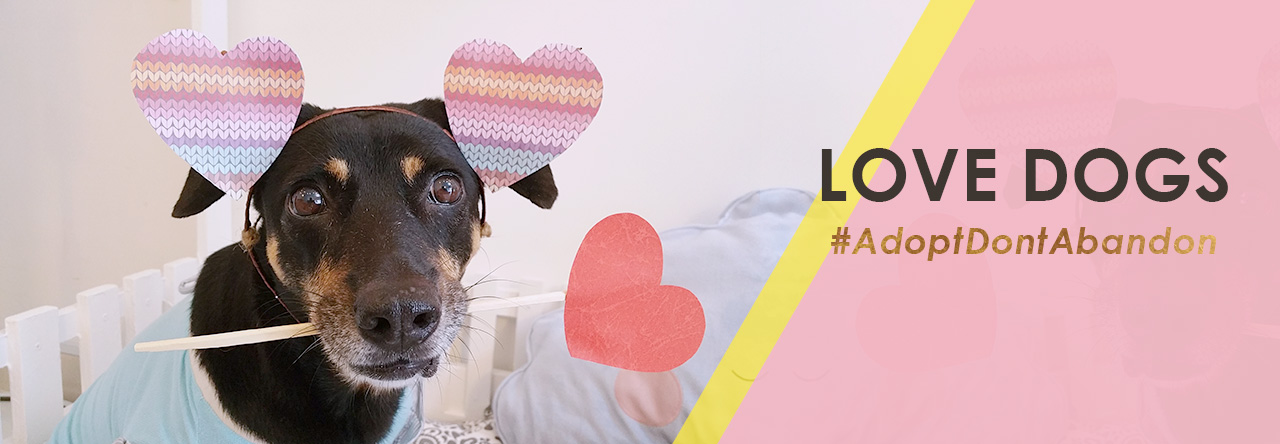We met Uncle Gardener again this morning on our walk. Donna seem to recognised him from the previous two times we bumped into him. Her tail was wagging and friendly. She sniffed around his legs, probably checking out the cat scent, but was having too much fun on her own to “sit” or “paw”. Things seem to be going well until Uncle Gardener reached out his hand to pet her on the head. She jumped and her head hung low to avoid his hand. Everything about her screamed nervous.
For all she is friendly and playful, this dog does have random episodes where she reacts fearfully. Early on, Florence had pointed out to us how Donna is so ideal in the home environment, we had thrown a toy which landed near a bunch of big boxes stacked together, that dog was almost tiptoe-ing around the boxes as she carefully grasp the toy in her teeth before cautiously returning back to us with the toy.
Donna is a very cautious dog. Sometimes we wondered if it was because she was abused in her previous family.
Sometimes, we understood that her cautiousness was with good reason. When we got a new dog in her house, friends and family who liked animals would want to visit and play with the dog. These friends and family unfortunately are strangers to Donna and when the strangers’ focus are trained on her and they make a beeline for her once they enter the house, she starts to get nervous and she will siam. Yup, at these times, she becomes the master at avoidance tactics.
It didn’t help that some family members are rough and think that they need to show the dog who is the boss first, even if at the end of the day they just want to shower affection on the dog. It also did not help that people naturally want to help the poor scared dog, and end up cornering her to pet her.

When pursued by “strangers”, the nervous Donna will usually bunch up in her bed after she gives up avoiding them. But in this picture, she just wanted to be left alone because it is her bedtime.
These situations could have ended up badly, if Donna was not the type of dog to downstress and just freeze on the spot versus becoming fearful aggressive instead. I read that a dog that downstresses may also react violently when pushed past a threshold. With Donna, we have never reached the aggression threshold yet.
Much later, I met a guy from the Save Our Street Dogs organisation at a new grooming place I was trying out, and he told me that this contradictory behaviour of being fearful and yet calm (frozen in one spot rather than kicking and screaming and showing teeth) at the same time was a behaviour that our local street dogs are genetically predisposed to show.
Interesting, so Donna is genetically programmed to go from fearful avoidance and then to fearful acceptance, without the aggression?
I’m not so sure about that. What I do know is that Donna is not incapable of aggression. She has a “mortal enemy” at the shelter called Grace, a dog whom she would with certain predictability lunged at, only to be stopped by the leash and even then, the handler needs great strength to hold her back as she tears at the air.
But we have not seen this aggression away from the shelter. Not once.
Meanwhile, we’ve tried with limited success to help family members and friends learn how to not approach Donna in order to make the introduction to her a success. (Sometimes, older folks have their own opinions and think we are spoiling the dog. My goodness, they have NOT seen a spoiled dog, I tell you!)
We have also been making Donna go to her bed and lie down in a relaxed position so that she may slowly learn to find calm there, especially when she may potentially feel fear. It’s sort of like crate training, but without the crate since we don’t have one yet.
I try to get the inquisitive little girl to go to her bed and to lie there before opening the door when the doorbell rings. She may not always stay since she is the very soul of a busybody, but she does at least stand around 2m behind me, near her bed as I answer the door, which leaves space between her and the people at the door who may need to come in.
It’s working pretty well, whether it is the dog supplies delivery man, the carpet cleaning salesman, etc. We complete our transactions while Donna stands and watches on. Sometimes, she is amenable to come closer to sniff at an offered hand, especially when she sees the nice man is delivering her food.
But yes, we do have a bit of a way to go when it comes to socialisation and helping her feel more confidence.

Yup, she also gets nervous when the weekend cleaning lady starts to vacuum the floor.















































